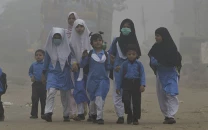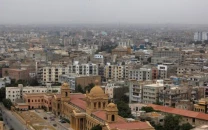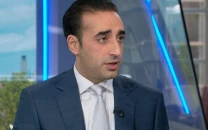The making of Garhi Khuda Buksh
The Bhuttos’ final resting place - two designs and almost two decades in the making.

At night, powerful beams light up the domes of the ‘Taj of Garhi Khuda Buksh’, casting a glow of simple splendor over its surroundings.
The history of the mausoleum at Garhi Khuda Bukhsh in Larkana began in 1979 when Zulfikar Ali Bhutto was laid to rest here. Though little known at that time, this was the ancestral graveyard of the Bhutto family.
Though the graveyard dates to before the British Raj, it was not until 1993 that Benazir Bhutto decided to turn it into an official mausoleum.
Describing her brother Shahnawaz’s funeral in her autobiography ‘Daughter of the East’, Benazir wrote: “And Sanam and I still had to pick out the site for his grave. We hadn’t been able to do that for my father. This time I wanted to be able to plan the space, to place Shah far enough away from my father so there would be room later to build mausoleums for both of them.”
As an edifice over the graves of Bhutto family elders already existed, a competition was held to decide the best design for the mausoleum.
Former Larkana nazim Khursheed Junejo, who supervised its construction, told The Express Tribune how Zaigham Jaffery was initially appointed the architect from 1993 till 1997. After that, construction work paused for a while and Benazir expressed the desire for a more Islamic style design. In 2003, the project was restarted and a second competition was held.
A committee was formed and Benazir looked at 11 shortlisted presentations by both national and international designers.
Finally, the proposal made by architect Waqar Akbar Rizvi came out on top as his design received the committee’s unanimous approval. His design, however, did not sit too well with the original architect, Jaffery, who told The Express Tribune of his original vision for the mausoleum.
“They told me that Benazir and Nusrat Bhutto had looked over all of the designs personally in Islamabad,” he recalled. “She got in touch with me immediately after.”
The first of their hurdles came up soon after. “The graves of the Bhutto gentlemen were not laid out in a precise order so it was difficult to stick with the original design which was meant to cover her immediate family.”
The extended Bhutto family members then insisted that the entire gravesite should be constructed properly as it was, after all, a family graveyard.
“When I started working on the site, Benazir asked me to visit Ayatollah Khomeini’s and Kemal Ataturk’s mazaars and draw some influence from them. I went on my own expense and tried my best to incorporate what I saw there.”
“I tried to incorporate the Shalimar Gardens into the structure. My original design did not have any domes in it, I don’t know who gets credit for that now but it wasn’t my idea,” he explained. “What I had wanted were five arches - which would reach out like arms, they represented the five great things Zulfikar Ali Bhutto had done.”
Master Plan: Circles and squares
The main concept was to incorporate the existing ground level structure while integrating an Islamic style dome in keeping with local culture. The best way to do this was to reinforce the existing structure and to use a lightweight material for the main mausoleum to avoid overloading.
The main theme revolves around squares and circles - a square platform, with a central dome encircled by four smaller domes. The number of domes, five, was picked for its significance in the Islamic world. The domes, circular at the base with huge pedestals on top, are steel structures covered by light ferro-cement concrete.
The mausoleum - main building
The main entrance is from the West to East staircase, there are two more staircases at the front while another two are on the inside. The ground sinks down right below the main dome and the floors all around it are raised with hanging balconies and verandas at all four corners for visitors. The floors are of gleaming white marble tiles with floral borders.
The external surface of the building is coated in the same super white marble with a combination of golden marble. The interior and artwork were planned separately and glazed tiles inscribed with calligraphy and fresco work and based on Sindhi Hala patterns have been used inside and outside the mazaar.
During her last visit to the mausoleum, Benazir sat beside the grave of her father and read the Holy Quran and expressed the wish to also be buried there. Now, she and her two brothers, Murtaza and Shahnawaz lie there beside him.
External development
There are 58 acres of land surrounding the mausoleum. In accordance with Benazir’s wishes there are a total of five entrances developed into a compound wall - two on each side and a main entrance. Each doorway is covered with a beautifully designed burj. The compound is large enough to house huge gatherings on the anniversaries.
As you enter the compound from the main entrance, the central aisle leads to the main stage made for public addresses on such occasions. The aisle is flanked with fountains and decorated pavements.
The courtyards are replete with pole lights and flowerbeds while the main mausoleum is lit up with floodlights mounted on high-rise towers - a breathtaking view at night.
The entire structure is designed for large public gatherings, which is why toilets, huge car parking spaces to the right and left of the compound and a helipad were factored in.
Deceased Bhuttos: Buried at Ghari Khuda Baksh
Sir Shah Nawaz Khan Bhutto and his wife, Lady Khurshid
Sikander Bhutto
Imdad Ali
Zulfikar Ali Bhutto
Shahnawaz Bhutto
Murtaza Bhutto
Benazir Bhutto
Nusrat Bhutto
With writing by Tooba Masood and Husna Anwar and images and additional information published in Archi Times’ December 2008 by Architect Syed Raza Abbas
Published in The Express Tribune, October 25th, 2011.














COMMENTS
Comments are moderated and generally will be posted if they are on-topic and not abusive.
For more information, please see our Comments FAQ